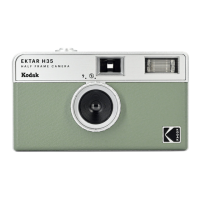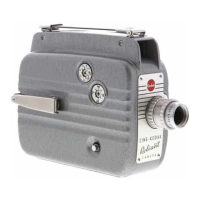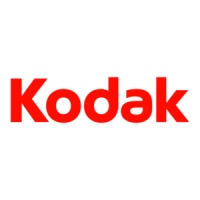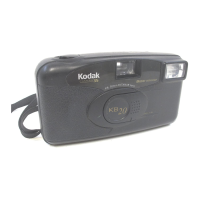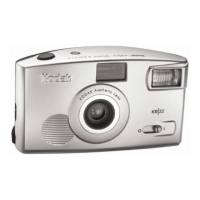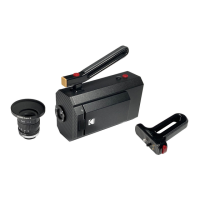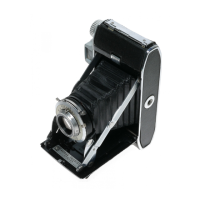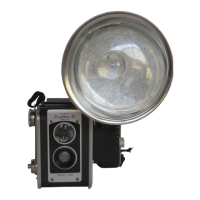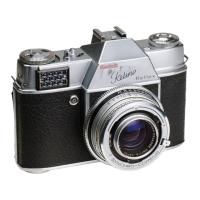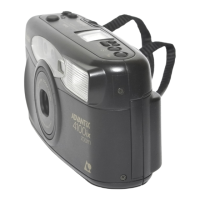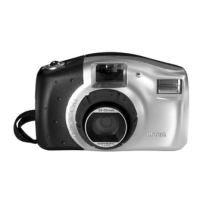20
CARE & STORAGE OF FILM & PRINTS
Leaving your film and camera in a
hot
place
such as a sunny
window
or
a closed
car
on
a warm day may lead to reduced
picture
quality. If you inadvertently leave the film and
camera in a
hot
place, allow them to cool
to normal temperature before taking any
pictures. If there
is
a film
pack
inside the
camera, wait approximately one
hour
after
the surface
of
the camera is cool to allow
adequate
cooling
of the film .
Also allow your film and camera to return
to normal temperature if they have been left
in a cold place such as a
car
trunk
during
winter.
Store your developed prints in a cool, dry
place. Print
colors
will remain
unchanged
longer if pictures are protected from long
exposure to bright light.
Each
picture
is a sealed unit that
contains
a caustic fluid. Never
cut
, trim,
puncture
,
tear,
or
separate the
picture
unit
,
si
nce
this
may
allow
so
me
of
the fluid to
escape
and
come
into
contact
with skin
or
eyes.
If
there
is any
of
thi
s
fluid
or
other
foreign
material
on the
print
surface
,
remo
ve
it
with a
damp
cloth
.
Any
cloth
containing
fluid
should
then
be
dis
carded
.
CAUTION
Picture units
contain
a
caustic
fluid.
Normally fluid will
not
appear. If it does,
alkali burn may result from
direct
contact.
Keep fluid away from eyes, mouth, and
skin. Avoid fluid
contact
with fabrics,
car-
peting, and
furniture
to
prevent stain.
• In case of
contact
with eyes, immedi-
ately flush
with
plenty
of
water and get
medical atte·ntion. In case of any
other
contact
, wash.
thoroughly
at
once
.
CARE OF YOUR CAMERA
With
proper
care and handling, your camera
will provide you with years of enjoyment.
When you're not taking pictures, protect
your camera by carrying or storing it
in
a
case such as the
KODAK
Instant Camera
Case, Model
A.
Clean the viewfinder lenses and the pic-
ture-taking lens by blowing away any dust
or
dirt. Then breathe on the lenses to form
a mist, and gently wipe the mist away with
a soft, clean, lintless cloth
(or
use a
drop
of
KODAK
Lens Cleaner and then wipe with
a clean, soft
cloth)
.
If specks of dust
collect
on the mirrors
inside the camera (indicated by small
dark
shadowy spots in the same location on
con-
secutive prints), use a rubber syringe to blow
air into the film
compartment
(see page 24).
Never
attempt
to clean the
mirrors
with a
brush
, a
cloth
,
or
any
other
cleaning
ma-
terial!
Store your camera and film away from heat
and
direct
sunlight-never
in the glove
com-
partment, on the rear-window shelf,
or
in any
other "
hot
spot" in a
car-since
this may
cause
permanent
damage
to
the film
or
the
camera. If you store your camera for an
extended period of time, it's a
good
idea
to
remove the batteries.
20
CARE & STORAGE OF FILM & PRINTS
Leaving your film and camera in a
hot
place
such as a sunny
window
or
a closed
car
on
a warm day may lead to reduced
picture
quality. If you inadvertently leave the film and
camera in a
hot
place, allow them to cool
to normal temperature before taking any
pictures. If there
is
a film
pack
inside the
camera, wait approximately one
hour
after
the surface
of
the camera is cool to allow
adequate
cooling
of the film .
Also allow your film and camera to return
to normal temperature if they have been left
in a cold place such as a
car
trunk
during
winter.
Store your developed prints in a cool, dry
place. Print
colors
will remain
unchanged
longer if pictures are protected from long
exposure to bright light.
Each
picture
is a sealed unit that
contains
a caustic fluid. Never
cut
, trim,
puncture
,
tear,
or
separate the
picture
unit
,
si
nce
this
may
allow
so
me
of
the fluid to
escape
and
come
into
contact
with skin
or
eyes.
If
there
is any
of
thi
s
fluid
or
other
foreign
material
on the
print
surface
,
remo
ve
it
with a
damp
cloth
.
Any
cloth
containing
fluid
should
then
be
dis
carded
.
CAUTION
Picture units
contain
a
caustic
fluid.
Normally fluid will
not
appear. If it does,
alkali burn may result from
direct
contact.
Keep fluid away from eyes, mouth, and
skin. Avoid fluid
contact
with fabrics,
car-
peting, and
furniture
to
prevent stain.
• In case of
contact
with eyes, immedi-
ately flush
with
plenty
of
water and get
medical atte·ntion. In case of any
other
contact
, wash.
thoroughly
at
once
.
CARE OF YOUR CAMERA
With
proper
care and handling, your camera
will provide you with years of enjoyment.
When you're not taking pictures, protect
your camera by carrying or storing it
in
a
case such as the
KODAK
Instant Camera
Case, Model
A.
Clean the viewfinder lenses and the pic-
ture-taking lens by blowing away any dust
or
dirt. Then breathe on the lenses to form
a mist, and gently wipe the mist away with
a soft, clean, lintless cloth
(or
use a
drop
of
KODAK
Lens Cleaner and then wipe with
a clean, soft
cloth)
.
If specks of dust
collect
on the mirrors
inside the camera (indicated by small
dark
shadowy spots in the same location on
con-
secutive prints), use a rubber syringe to blow
air into the film
compartment
(see page 24).
Never
attempt
to clean the
mirrors
with a
brush
, a
cloth
,
or
any
other
cleaning
ma-
terial!
Store your camera and film away from heat
and
direct
sunlight-never
in the glove
com-
partment, on the rear-window shelf,
or
in any
other "
hot
spot" in a
car-since
this may
cause
permanent
damage
to
the film
or
the
camera. If you store your camera for an
extended period of time, it's a
good
idea
to
remove the batteries.
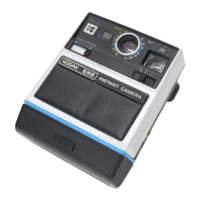
